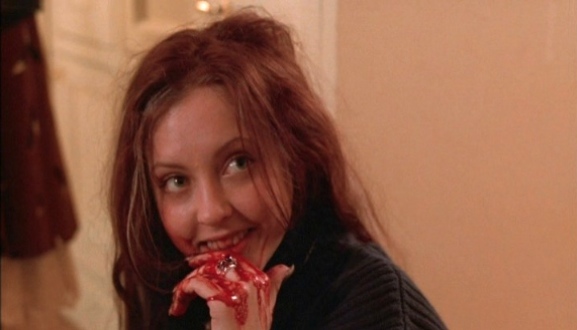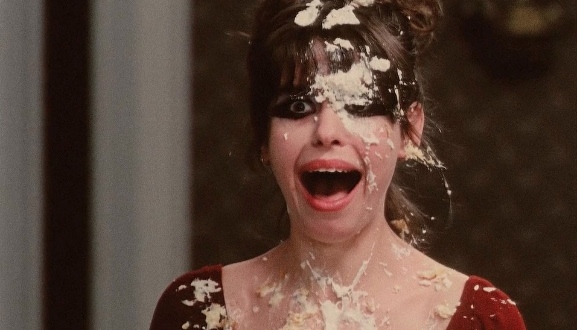
Brian de Palma’s 1976 film Carrie has become a seminal text in female horror for its blending of the trials of adolescence with a dash of the supernatural. The film opens with Carrie’s first menstruation, a mysterious and shameful event for the sheltered outcast. After the initial shock of the onset of womanhood, Carrie’s new maturity presents her with the possibility of being normal, biology initially promising to bring her back into the fold. In the tradition of teen fiction, the film leads up to the ultimate high school party: prom. Parties in teen movies like Carrie come to represent a microcosm of society’s archetypes—the pretty, the popular, the weird—and those who fail to fit in are rejected or punished. With the extreme emotions of adolescence, everything from the school dance to a math quiz becomes a matter of life or death, ripe territory for the metaphors and symbolism of the horror genre.
At the heart of this adolescent evolution is blood: from Carrie’s first bleeding to her humiliating and iconic encounter with pig’s blood, her menstruation becomes the pivotal symbol of horror in the film. The offbeat genre of menstrual horror is in tandem with the plot arcs and expectations of teen film, a genre of movies that almost always leads up to some kind of party. Blood becomes the conduit for expressing femininity within the narrative, not just a consequence of physical violence.
Drawing heavily from this model of menstrual horror, John Fawcett’s dark Canadian horror-comedy Ginger Snaps (2000) charts the intimate friendship between two sisters in suburban Ontario. The film twists the story to feature two girls who, unlike their filmic predecessor, dread nothing more than normalcy. Inexplicably, at fifteen and sixteen respectively, neither Brigitte (Emily Perkins) nor Ginger (Katharine Isabelle) have had their period. Brigitte wishes the pair of them could wait out their adolescence in their dark minimalist basement lair (their bedroom contrasts the rest of their suburban Ontario home, which is decorated with crafts and dried flowers), instead of being forced to endure the awful cesspool that is high school. The intensity of the sister’s bond is emphasized by their suicide pact: in an early scene, Ginger spells out their childhood promise, “Out by sixteen or dead on the scene, but together forever.”
Yet all this changes on the night of Ginger’s first period, when she is consequently mauled by a werewolf. The “curse” maintains a double meaning throughout the film. The first is the normal biological changes of adolescence, but the second, more frightening consequence is Ginger’s transformation into a lycanthrope. For Ginger, the initial trauma of her first menstruation is what she experiences as the betrayal of her body. As it so happens, her period reveals that she is not different after all—she is, fate of all fates, just like everyone else. The physical and mental changes Ginger goes through, leading up to a Halloween party called “The Greenhouse Bash,” blur the lines between the normal and the monstrous.
The early symptoms of lycanthropy are not very different from puberty at all: hair in places it wasn’t before, a spike in sexual desire, and changes in personality. The mythology within the film refutes traditional ideas of werewolves, most notably having lycanthropy spread like a disease: it is passed on just as easily through unprotected sex as through a bite. After it becomes increasingly clear that Ginger is not just going through puberty, Brigitte enlists the help of Sam (Kris Lemche) to find a cure for lycanthropy. On the night that Ginger was bitten, Sam had run over the werewolf who bit Ginger with his truck, killing it instantly. Sam is a local stoner and works at the greenhouse. He has a reputation of being a cherry-hunter (a man who preys on virgins) and his van is usually parked in the high school parking lot. As Ginger continues to transform, and he spends more time with Brigitte, his presence puts particular tension on the sister’s relationship. Ginger habitually accuses him of trying to sleep with her younger sister.
Ginger’s transformation is tied very clearly with her sexual awakening, and she replaces the close bond with her sister Brigitte with a new carnal relationship with Jason (Jesse Moss), one of the popular guys at school. Just as hungry for sex as he is and consistently shown as the sexual aggressor, Ginger knows what she wants. The night she loses her virginity, she is seen pressuring a befuddled Jason into sex. He asks her to slow down and she responds by pinning his arms behind him. There is little doubt that Ginger rapes Jason in this encounter, which leaves him bruised and jittery. Ginger not only robs him of any opportunity to feel satisfaction over his conquest, but also infects him with the “curse.” In contrast to Ginger, the virus slowly exaggerates the worst of adolescent hormones in making Jason pimpled and sweaty. He also seems to get some menstrual variation, his pants stained with an increasingly large spot of blood. The apparent trauma of the experience sends the otherwise cocksure alpha male into a state of anxiety as he retreats from being the centre of attention.
When Ginger returns home that night after her first sexual experience, she’s covered in blood and filled with regret. She does not bemoan the lack of magic in her first sexual experience, but rather its social consequences: while Jason will be celebrated as the dude who got laid, Ginger will be relegated to the role of “freak mutant lay”—the weird slut. Not only is Ginger pointing to the archaic double standards imposed on female sexuality (Brigitte and Ginger are called sluts on numerous occasions), but her anxiety reveals a more personal confession that she cares what others think of her. Her fear of this inevitable high school vitriol is about the collapse of the tough facade she has carefully built for herself.
It becomes clear that Ginger’s rebellion is posturing since she really does care what others think of her. This revelation changes our perception of the sister’s suicide pact. As the two discuss their suicide, Brigitte expresses doubts. She is afraid that when they discover her body, they will laugh at her (echoing Piper Laurie’s sneering “they’re all going to laugh at you” which haunts Carrie during her humiliation), but Ginger passionately argues that the witnesses to their death will be in “awe.” This moment serves a dual purpose of suggesting Ginger’s power in the sister’s relationship, but also more crucially that she very much cares what others think of her. Her reason for suicide is not to be with Brigitte forever but to express to society the control she has over her body and image. This ties into the sister’s macabre artwork, which establishes Ginger’s desire to express her identity through her body and sexuality (the girls create faux-crime scene photos of their own suicides—their bloody, lifeless corpses the focal point). Although this happens before her period or before she is bitten by a werewolf, all the signals of her sexual awakening are present. Already Ginger has become aware of the boys in her class and has begun revelling in the newfound attention. Ginger is not afraid of being normal so much as she is afraid of being a nobody.
Beyond the idea of menstruation, blood is tied to our understanding of family. Since Brigitte and Ginger are sisters, the idea of their “shared” blood helps to establish the illusion that the girls are the same, even part of each other. That they are family helps to separate them from the rest of their peers, offering another pretense for their self-imposed alienation. Their blood becomes a concealment for how much they are like the people they mock and deride, their blood representing a false promise that they are and will remain different from the rest. While they share the same blood, the same lineage, and the same gender, Ginger’s lycanthropic transformation is not a journey they’re able to take together.
As the Halloween party is filled with costumed teens in masks and makeup, Ginger’s drastic transformation into a werewolf is not out of place, and she can enter the party without needing to hide her new, hideous appearance. As Ginger passes through the blue strobing lights of the bash, she foregoes the easy victims of the young teenage boys hungering for her body. She goes straight to Sam and immediately attempts to seduce him. In earlier scenes, Ginger has at least a superficial desire to protect her younger sister from Sam, but at this point her goal to infect or consume Sam does not seem to be with the noble, if not misguided, goal of protecting her sister from him. Though Ginger retains some vestige of humanity in her physical appearance, she has fully embraced her bloodlust and impulse towards self-destruction.
While Ginger represents a sort of alpha of the pack by the time of the party, Brigitte has meanwhile demonstrated herself as the true rebel of the sisterhood. While still an outcast, as demonstrated by her difficulty navigating through the party space, Brigitte has opened herself up to the world rather than remaining closed off. The initial promises of cutting themselves off from the world and riding out adolescence in their basement are long gone, the party space being the last threshold Ginger has crossed—a signal of her final transformation and separation from Brigitte. By this point, the friendship between them has all but dissolved. As the film moves away from the party and into the film’s final act which reunites the two in their minimalist basement, everything has changed. Brigitte, awakened to the world around her, is willing to sacrifice her own well-being to save her sister, but it is too late. Ginger has become the beast and there is no turning back.
Ginger Snaps is perhaps the only teen horror film to connect the idea of werewolves to the menstrual cycle. While other films, such as Teen Wolf (1985) and I Was a Teenage Werewolf (1957) use lycanthropy as a metaphor for growing up, they do not reflect the feminine experience. This is a film that tackles the unique struggles of being a teenage girl, and the particular social concerns that emerge with a woman’s transforming body. It seems for women in particular, puberty means assimilation. Early scenes show that these girls fear nothing more than normality, fading into nothingness: menstruation represents their body betraying their desire to be unique. Yet, this very idea is undermined by the very structuring of the film which takes a familiar werewolf narrative and infuses it with new life. Real change lies far deeper than the physical changes of puberty, it lies in the mental change that comes from knowing your curse isn’t really a curse—it’s a conduit to self-discovery. You aren’t defined by the “curse” of puberty any more than a werewolf movie is defined by the curse of lycanthropy.





